Diadophis punctatus
—
Ring-necked Snake
Also known as:
Ringneck Snake
Subspecies I've seen:
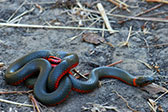
D. p. amabilis
Pacific Ring-necked Snake
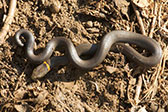
D. p. arnyi
Prairie Ring-necked Snake
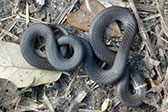
D. p. punctatus
Southern Ring-necked Snake
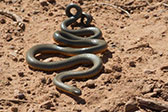
D. p. regalis
Regal Ring-necked Snake

D. p. vandenburghi
Monterey Ring-necked Snake
Diadophis punctatus amabilis
—
Pacific Ring-necked Snake

I was surprised to see this pretty little ring-necked snake under a small board in the dry month of October. Ring-necked snakes are usually found when the ground is moist, but the rainy season had not yet begun.
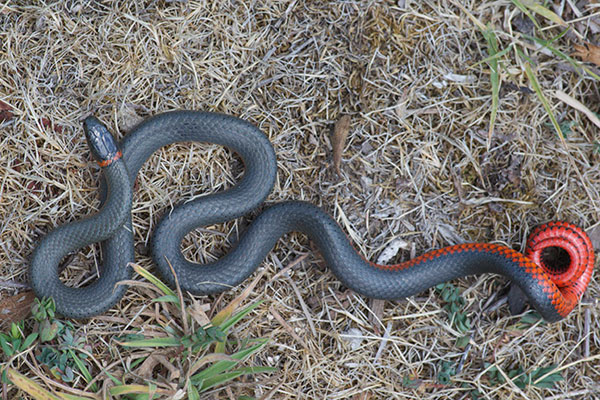
Another from the same area, with very similar bright coloration. These guys are so much prettier than many of the other subspecies, such as the ones I've seen in Kansas.
Diadophis punctatus arnyi
—
Prairie Ring-necked Snake
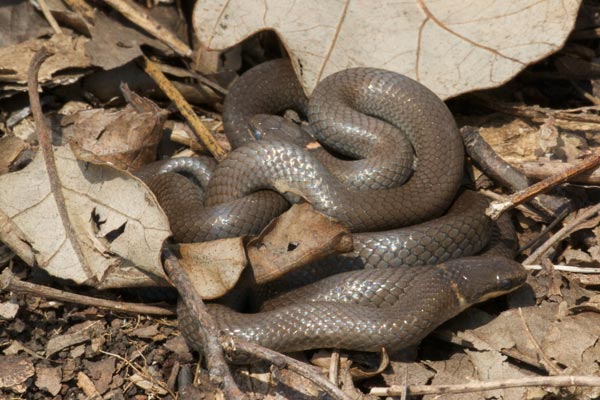
I wasn't expecting to see many herps when we stopped at this small natural area, both due to its proximity to Kansas City and due to the coolness of the morning. Come to think of it, I didn't actually see much, but I did see my first and second Prairie Ring-necked Snakes (under the same rock), as well as a few five-lined skinks.

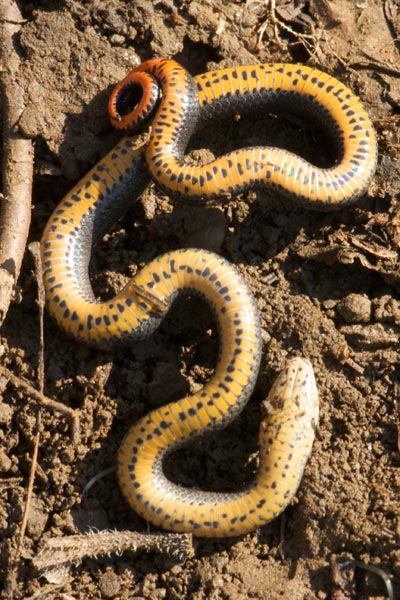
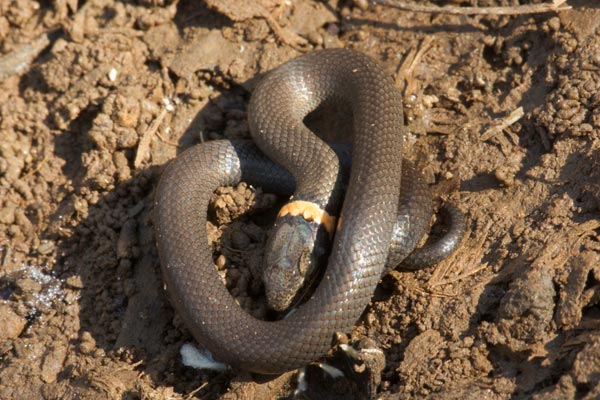
This was my first experience with looking for snakes in Kansas, a place famous among people who look for snakes. I'd driven across Kansas a couple of times before, but we were always in a hurry to get to Colorado where my parents live, and the weather had never been cooperative. It wasn't particularly cooperative on this day either, being pretty cool in the morning when we had just a couple of hours to spend walking the dogs and looking for wildlife. But the dogs had a good time and I uncovered eleven Prairie Ring-necked Snakes on a couple of hillsides. The snake in the second picture is the same snake as in the first picture; it decided to play dead hoping I would leave it alone (which I did pretty soon in any case).
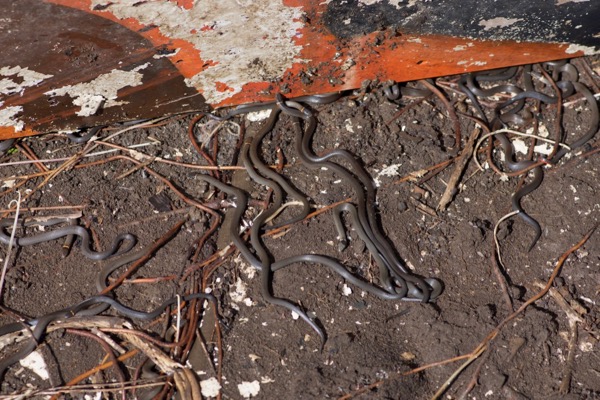
The hard part about photographing ring-necked snakes in western Missouri is not finding them. We estimated that there were about 30 under this board, and I saw another 180 or so on the rest of this four-day trip. The hard part is that you get overwhelmed by their numbers; it always seems (and probably is) more worthwhile to go look for some other less common species than to spend any time getting any one ring-necked snake to sit still for a photo session.
Diadophis punctatus punctatus
—
Southern Ring-necked Snake

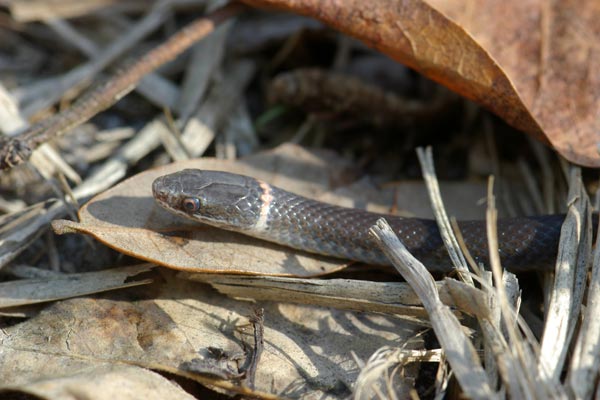
Peeling old palm fronds away from the ground led me to discover two cute little ring-necked snakes on this pleasant Florida morning. This broke my snake string of seven straight Eastern Racers.
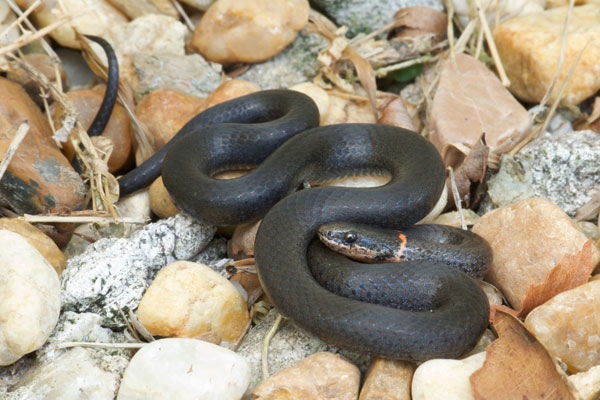
While staying at my mother-in-law's house in southern Florida, I was bemoaning the paucity of snakes I had come across in the few weeks we had been there. On the last day of our stay, we were heading out for our favorite lunch (Miami's Best Pizza, if you must know) when I glanced down to see this pretty little guy a few inches outside the front door.
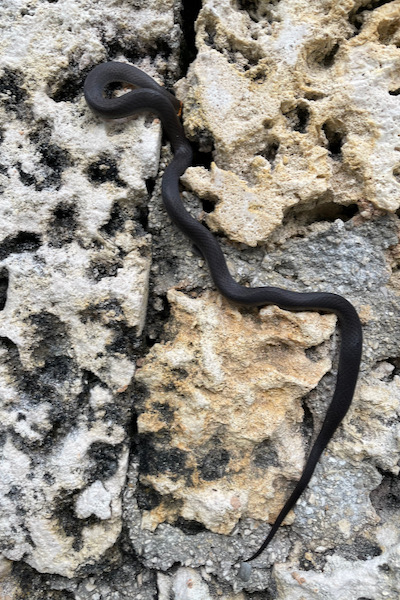
This is the first ring-necked snake I've seen that was several feet off the ground, exploring the nooks and crannies of a coral-block wall.
Diadophis punctatus regalis
—
Regal Ring-necked Snake

The Regal Ring-necked Snake is both the largest subspecies and the one most adapted to arid conditions. And indeed, this snake was longer than any ring-necked snake that I'd previously seen, and there was no water to be seen in the area.
Like many Regal Ring-necked Snakes, this one was lacking an actual ring around its neck. Kind of poorly named, really.
Diadophis punctatus vandenburghi
—
Monterey Ring-necked Snake
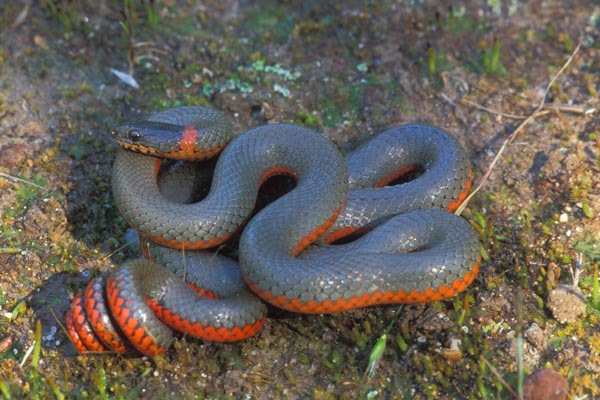
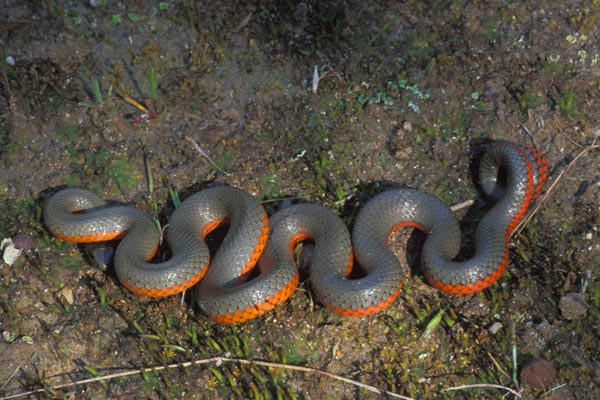
Ring-necked snakes are widespread and relatively common, but they are quite secretive so they're mostly seen by people like me who are actively looking under boards, rocks, etc. Even so, it took me several years of living in ring-necked snake territory before I finally got a photo of one. (I had seen one earlier disappearing into a crack.)
Ring-necked snakes are drab above but bright orange/red below. When cornered, they twist up tightly and flash their bright bellies. I'm not sure what survival value this has, but it presumably does them some good. This one was a small adult, at about 8 inches long.
A note on the spelling of the scientific name of this species: it's been spelled at least three different ways in various places — "vandenburghii", "vandenburgii", and "vandenburghi". Dr. Brian Crother, editor of the SSAR names list, told me in personal communication that "vandenburghi" is the correct spelling.
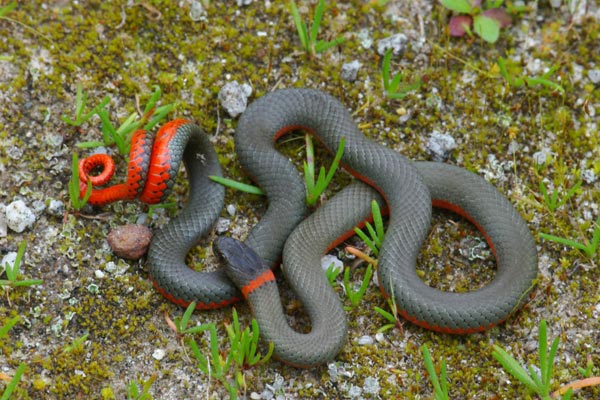
During 2004 I was in Florida for the entire spring ring-necked snake season, but in 2005 I made it back to Fort Ord during the right conditions and found another little beauty.
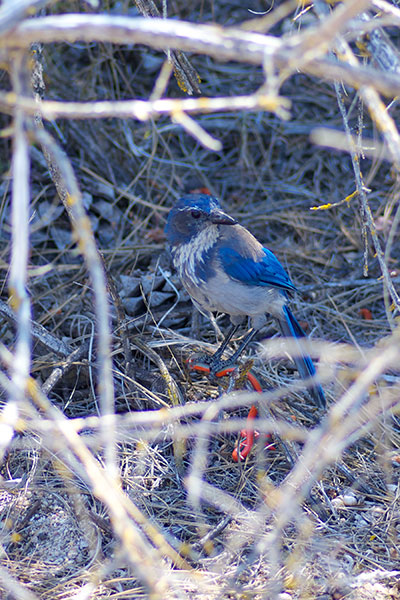
I came across three hikers who had paused to watch something in the nearby bushes. It turns out they had been watching this scrub jay wreaking havoc on this little ring-necked snake. The bird was grabbing the snake and thrashing it violently about, even though it looked to me like the snake was long dead.
Printed references:
- Bartlett, R. D., Tennant, A. 2000. Snakes of North America, Western Region
- Basey, H. E. 1976. Discovering Sierra Reptiles and Amphibians
- Behler, J. L., King, F. W. 1979. The Audubon Society Field Guide to North American Reptiles & Amphibians
- Brown, P. R. 1997. A Field Guide to Snakes of California
- Conant, R., Collins, J. T. 1998. Peterson Field Guide to Reptiles and Amphibians of Eastern and Central North America, Third Edition, expanded
- Crother, B. I. (ed.) 2017. Scientific and Standard English Names of Amphibians and Reptiles of North America North of Mexico, with Comments Regarding Confidence in Our Understanding, Eighth Edition
- Degenhardt, W. G., Painter, C. W., Price, A. H. 1996. Amphibians & Reptiles of New Mexico
- Hanson, J., Hanson, R. B. 1997. 50 Common Reptiles & Amphibians of the Southwest
- Henson, P., Usner, D. J. 1993. The Natural History of Big Sur
- Schoenherr, A. A. 1992. A Natural History of California
- Shedd, J. D. 2005. Amphibians and Reptiles of Bidwell Park
- Smith, H. M., Brodie, E. D. Jr. 1982. Reptiles of North America: A Guide to Field Identification
- Stebbins, R. C. 2003. Peterson Field Guide to Western Reptiles and Amphibians, Third Edition
- Stoops, E. D., Wright, A. 1997. Snakes and other Reptiles of the Southwest, 4th Edition
- Wauer, R. H. 1964. Reptiles and Amphibians of Zion National Park